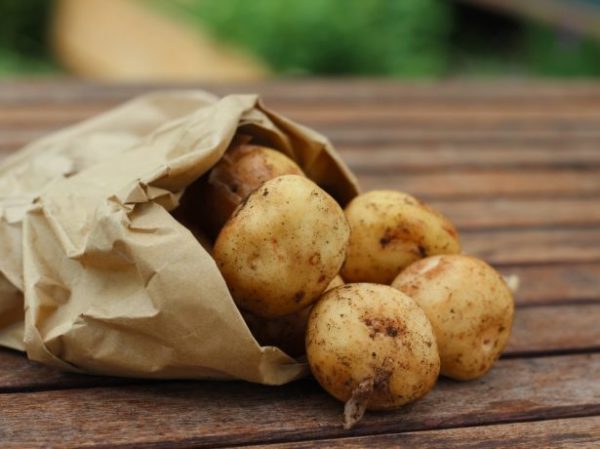
Potato Kolobok - one of the fruits of the joint efforts of the team of the All-Russian Research Institute of Potato Economy. A.G. Lorch, creator and originator of many varieties of potatoes that have been cultivated in the regions of Russia for a decade. The description of the variety indicates that the tubers grow with a yellow skin and the same flesh, and get a round or round-oval shape. This was the reason for the name of the undoubtedly successful variety.
Kolobok invariably receives friendly and favorable reviews from gardeners and plant breeders involved in its cultivation in personal subsidiary plots or for retail sale. The characteristic shape of the tuber and the medium-deep, but subtle eyes are clearly visible in the photo. The variety is loved not only for its simple planting rules and minimal wisdom of care, but also for its taste characteristics and suitability for industrial processing.
The characterization of the variety in suitability for industrial production says that the variety is ideal for the production of freeze-dried puree, frozen semi-finished product, and vegetable mixtures. Photos of the root crop, which can be grown up to 140 g in weight, are often placed on advertising leaflets, where its roundness and slightly rough yellow skin are clearly visible.
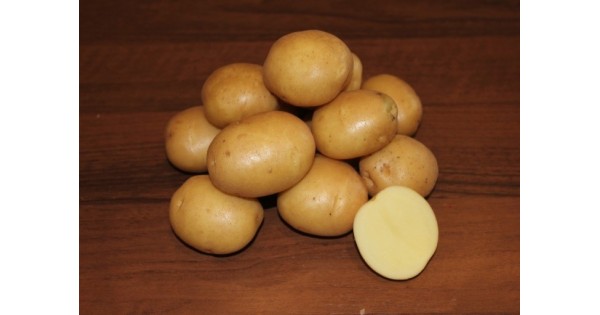
Content
Advantages and disadvantages of potatoes
Potato Kolobok is a successful work of domestic originators, and the list of its advantages invariably includes the following varietal features:
- mid-season table, with a period of reaching a state of ripeness - 80 days from the moment of planting;
- a yellow tuber with a high content of protein, amino acids and carotene, which has excellent taste;
- average potato - from 90 to 120 g, optimal conditions allow you to increase the tubers to 140 g;
- 15-20 potatoes ripen on the bush, which makes it possible to harvest more than many popular varieties;
- seed material, which many collect on their own, is not subject to degeneration and has excellent germination;
- low starch content makes it possible to use it in diet food;
- the calibration of the fetus is approximately the same, large, and small fruits are rare and in a small percentage;
- the variety is resistant to many types of pests, it is not exposed to potato cancer, common scab, viral and bacterial diseases, black leg;
- proper and timely top dressing can significantly increase productivity;
- the minimum collection is 127 centners per hectare without leaving, 224 - when agronomically courted, in a small area, with additional funds, it was possible to raise 256 centners per ha;
- the minimum yield is 87%, the maximum - 97%, which makes it a profitable crop for growing on an industrial scale;
- the bush grows medium-tall, with optimal stability, semi-erect and almost always allows you to do without additional hilling;
- with proper care and regular change of seed material pays the owner a high quality grown product.
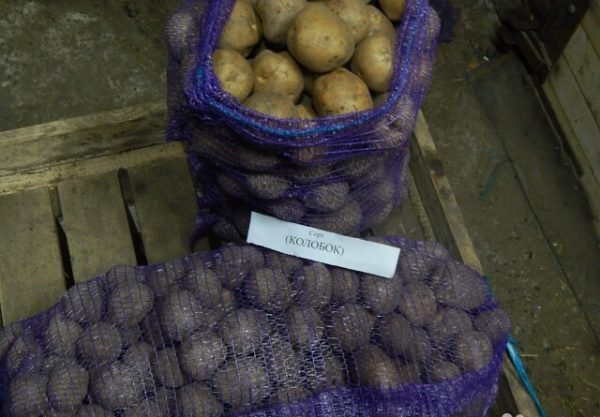
The disadvantages of the variety are conditionally attributed to the dense peel, which makes it somewhat difficult to clean for kitchen needs, but this same feature allows it to be highly preserved when digging. After entering the State Register in 2005, the variety became officially recommended not only for the Central, but also for the Central Black Earth region of the country.
For plant growers, a sign of the quality of the proposed fruit of the hard work of domestic originators is the fact that the team of the All-Russian Research Institute of Potato Farm was engaged in its breeding. A.G. Lorha. On the account of this institute there are more than a dozen successful developments.
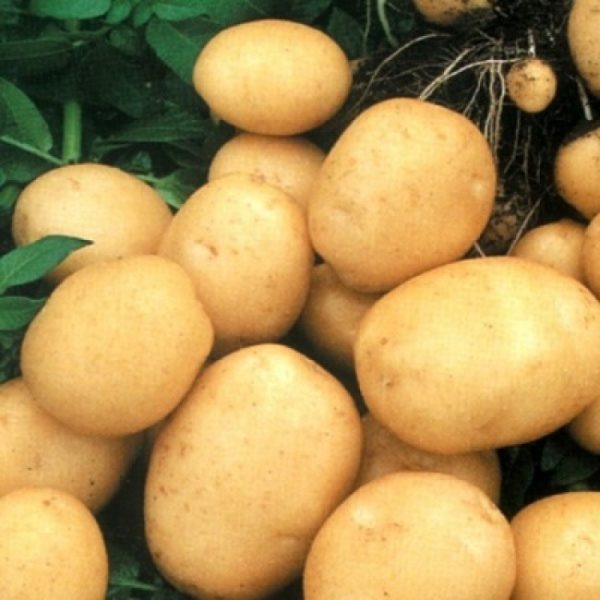
Growing rules
The description of the potato variety with the original Russian name Kolobok includes some features of its cultivation. They should be taken into account when breeding to obtain a high yield, it does not matter whether on a small plot of land or on an industrial scale:
- high yields from Kolobok can be achieved only by qualified and proper care, subject to certain nuances;
- a good, strong, stable bush and the maximum number of calibrated tubers can be obtained only with high-quality varietal material;
- Kolobok potato gratefully responds to top dressing with plant and chemical fertilizers, but with an excess of nitrogen expels green mass, gives fewer potatoes, and accumulates nitrates in them;
- top dressing should be done in certain rocks, and in the description of the variety they are always present;
- preference should be given to organic fertilizers: A.G. Lorch, whose name is named after the All-Russian Research Institute for the Development of Original Varietal Products, believed that chemical fertilizers spoil the taste of any potato;
- the correctly chosen method of hilling will not only retain moisture in the soil and prevent the occurrence of a bush, but also protect the tubers from greening and attack of the tracks of potato moths.
A variety can be dug up a little in the middle of summer for trade or food needs, and photos and reviews of gardeners say that in the stage of technical ripeness, it retains its excellent taste. But the final collection time comes at the end of the first decade of September. Excavated at this time, it is suitable for both long-term transportation and long-term storage. If the collected tubers are pre-sorted and dried, its keeping quality increases several times.
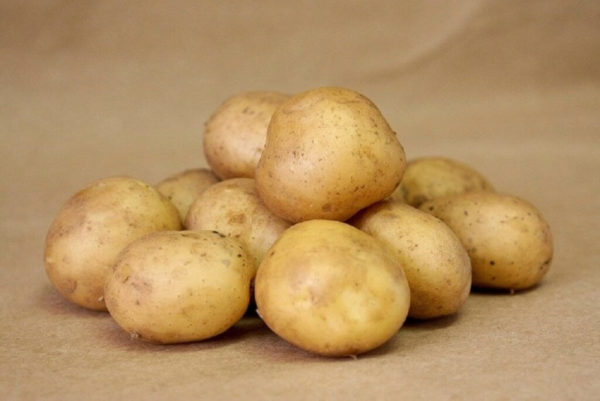
Some subtleties and features
Otherwise, the conditions for growing the Kolobok variety are no different from the requirements for other mid-season varieties:
- the distance between the holes and the row spacing - 35x60 cm;
- humus and ash are introduced into a hole 10 cm deep;
- for a good harvest, two-time hilling in standard terms is necessary;
- sprinkling is carried out in the dry period or at the first appearance of butterflies of potato moth;
- after flowering, watering is no longer required;
- Loosening and regular weeding from weeds are highly recommended as first-order actions.
If you periodically change the place of planting of potatoes, sowing it after cabbage, radish or dormancy, the yield will increase further.
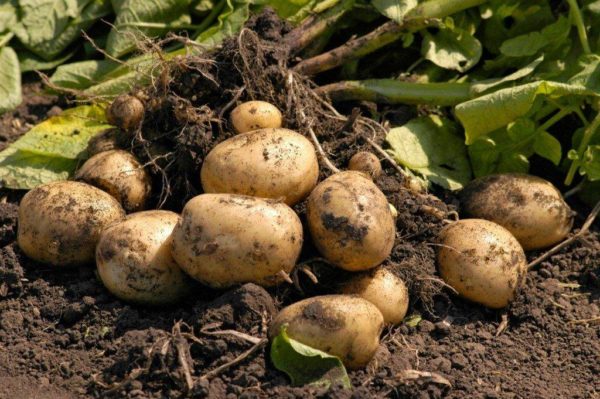
Diseases and Pests
The originator gave the variety relative resistance to common scab, late blight, and rhizoctonia. Preventive measures taken can prevent the occurrence of alternariosis. But it does not have resistance to the potato nematode and the relative resistance to late blight does not mean that it cannot occur if the summer is rainy and there is an excess of moisture. Therefore, for the Kolobok variety, prophylactic spraying with Poliram or Kurzat is recommended.
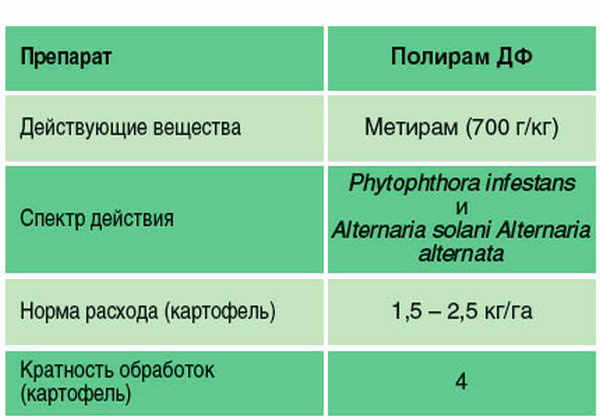
Timely weeding will help to avoid diseases that often get on potatoes from weeds. From the Colorado potato beetle and potato moth, insecticide treatment is carried out immediately as soon as the first adult individuals are noticed. Early spraying will require a lower concentration of the solution and will not allow them to lay eggs, from which the larvae can hatch.
To control pests, you can use proven folk remedies: planting plants that have the ability to scare away a pungent odor between rows, watering with ammonia and boric acid, spraying with potassium permanganate or infusion of onion husks.
The cultivation of the Kolobok variety is undoubtedly a profitable investment, which will give the maximum commodity yield with proper care.




 Description and description of varieties in Belarus with a photo
Description and description of varieties in Belarus with a photo Do I need to pick flowers from potatoes: why do they do it
Do I need to pick flowers from potatoes: why do they do it When to dig potatoes: timing and availability of new potatoes
When to dig potatoes: timing and availability of new potatoes How to grow a good potato crop: various methods and methods, planting and care
How to grow a good potato crop: various methods and methods, planting and care